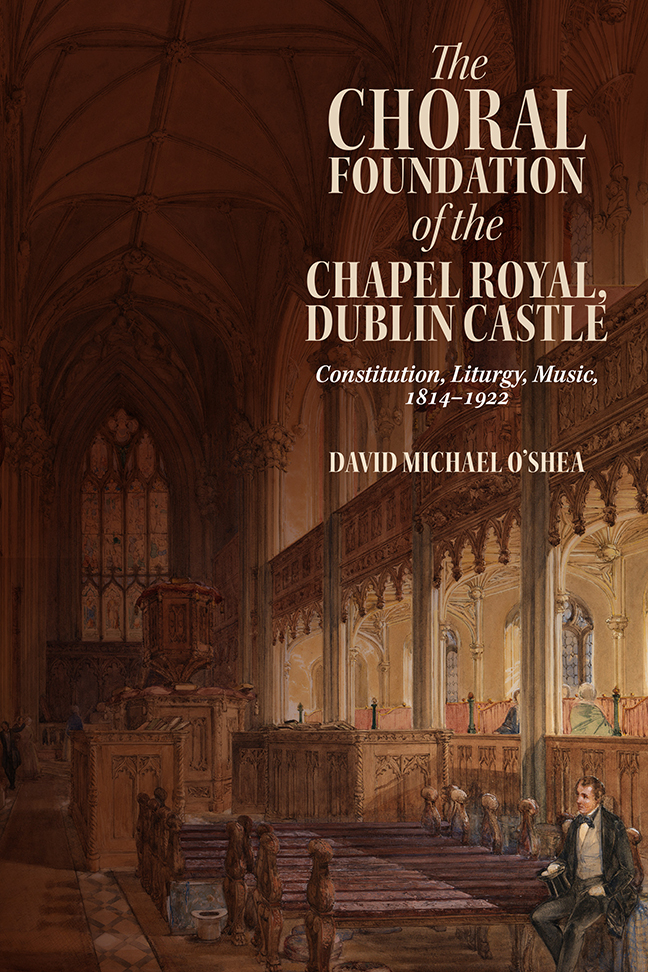Book contents
- Frontmatter
- Contents
- Illustrations
- Foreword
- Preface
- Acknowledgements
- A Note on Terminology
- Abbreviations
- Introduction
- 1 Precedents, Polity and Politics
- 2 Clergy
- 3 Churchmanship, Furnishings and Functions
- 4 The Musical Foundation
- 5 The Chapel Royal Music Collection
- 6 Singing the Liturgy
- 7 Organs
- 8 Boy Choristers
- 9 Gentleman Singers
- 10 Organists and Composers
- 11 The Chapel Royal's Legacy
- Conclusion
- Appendix A Lords Lieutenant, 1801–1922
- Appendix B Clergy of the Chapel Royal
- Appendix C Extant Chapel Royal Music Volumes (RCB MS 1113)
- Appendix D Boy Choristers of the Chapel Royal
- Appendix E Gentlemen Singers of the Chapel Royal
- Appendix F Organists of the Chapel Royal
- Appendix G Fragment of a Juvenile Chant by C. V. Stanford
- Bibliography
- Index
- Irish Musical Studies Previous volumes
4 - The Musical Foundation
Published online by Cambridge University Press: 10 January 2024
- Frontmatter
- Contents
- Illustrations
- Foreword
- Preface
- Acknowledgements
- A Note on Terminology
- Abbreviations
- Introduction
- 1 Precedents, Polity and Politics
- 2 Clergy
- 3 Churchmanship, Furnishings and Functions
- 4 The Musical Foundation
- 5 The Chapel Royal Music Collection
- 6 Singing the Liturgy
- 7 Organs
- 8 Boy Choristers
- 9 Gentleman Singers
- 10 Organists and Composers
- 11 The Chapel Royal's Legacy
- Conclusion
- Appendix A Lords Lieutenant, 1801–1922
- Appendix B Clergy of the Chapel Royal
- Appendix C Extant Chapel Royal Music Volumes (RCB MS 1113)
- Appendix D Boy Choristers of the Chapel Royal
- Appendix E Gentlemen Singers of the Chapel Royal
- Appendix F Organists of the Chapel Royal
- Appendix G Fragment of a Juvenile Chant by C. V. Stanford
- Bibliography
- Index
- Irish Musical Studies Previous volumes
Summary
The inception of the musical foundation
As we have seen, even before the building of the new Castle Chapel was completed, the Castle authorities had begun to plan a foundation that would mirror that of the chapel of St James's Palace in London. This is proved by a previously unnoticed letter in the National Archives of Ireland sent on 14th October 1814 by William Howley, Bishop of London and ex-officio Dean of the English Chapel Royal, to Samuel Slade, First Chaplain to the Lord Lieutenant. Enclosed with this letter was an account of how the choral service was performed at the Chapel Royal at St James's Palace written by William Holmes, Sub-Dean of the English Chapel Royal, and his suggestions as to how a similar (albeit more modest) choral foundation might be established in the chapel of Dublin Castle.
Holmes's letter reported that the English Chapel Royal choir at the time consisted of sixteen gentlemen, ten choristers, a master of the boys, two composers, and two organists. After explaining times of services and duties of various officials, Holmes made the following recommendations:
As ‘the Chapel of Dublin Castle is on a much smaller scale than the Chapel Royal’, the Choir might be reduced to one Organist, 2 Contra Tenors, 2 Tenors, and 2 Basses, with 6 or 8 Choristers.
The quotation marks suggest that this remark was a quotation from Slade's lost original letter to Howley, which was presumably a request for advice as to how the services of the English Chapel Royal might be imitated in the new Castle Chapel. Slade evidently considered these suggestions alongside other members of the viceregal administration, as enclosed with these letters is a document dated 30th November 1814, apparently making recommendations for the personnel of the new foundation:
Organist and Composer: Sir John Stephenson [sic]3 Organist: Mr Duncan
2 Tenors: Messrs Spray and Jager
2 Contra Tenors: Messrs Smith and Hamerton
2 Basses: Sir John Stephenson and Mr Hooper
6 Boys
1 Clerk of the Closet for the Ld Lieutenant (1 side)
1 for the opposite side of the Gallery
1 for below
From comparison with a letter of 1801 in Samuel Slade's hand, it appears that this list was not written by him.
- Type
- Chapter
- Information
- The Choral Foundation of the Chapel Royal, Dublin CastleConstitution, Liturgy, Music, 1814-1922, pp. 77 - 92Publisher: Boydell & BrewerPrint publication year: 2023



